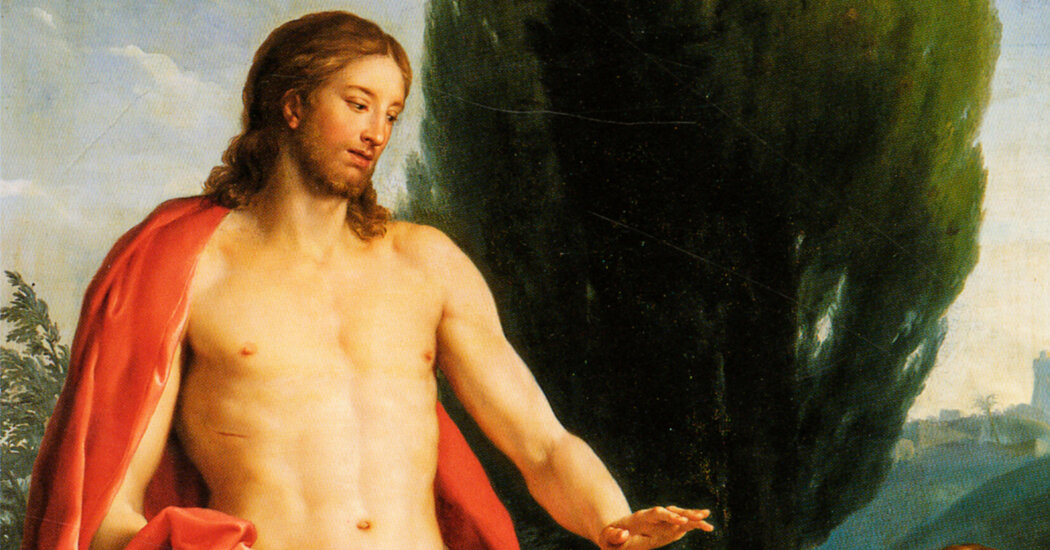LOWER THAN THE ANGELS: A History of Sex and Christianity, by Diarmaid MacCulloch
Christians today might disagree on any number of questions around gender and sexuality: Can women be members of the clergy? Can same-sex couples marry? Is reproductive choice a right? Is contraception a sin? Does gender transition affirm divine truth or does it transgress a God-given binary? But as Diarmaid MacCulloch explains in “Lower Than the Angels,” his magisterial new history of the many different Christian attitudes toward sex, these preoccupations define only the past half-century of the faith. For the previous 1,900 years or so, the most important question was this: Is it sinful to get married and have kids?
“Lower Than the Angels” sometimes veers into passages only a specialist could love, but this arcana is well balanced by MacCulloch’s dry wit and flair for narrative sweep. Recapping the millenniums-long debate over the unholiness of wedlock, MacCulloch — a distinguished scholar of the English Reformation, an author of award-winning books on church history and the son of an Anglican clergyman — lines up opposing columns of sex-positive and sex-averse Christian philosophers.
Into the prude column goes Jerome, a fourth-century translator of the Bible and a tireless foe of marital sex. People didn’t do it until after the Fall, Jerome noted. And Scripture aside, as he explained in a letter to a young widow in 394, the babies that often result are gross. Plus, being married is miserable, and remarrying would make her “like a dog” returning “to its vomit.” Stick with widowhood, Jerome said, and leave sex to the sinners.
Somewhat surprisingly, MacCulloch, looking for a pro-sex counter to Jerome, presents the fourth-century bishop Augustine. Though he was troubled by fleshly desire and also down on babies (“the feebleness of infant limbs is innocent, but not their minds”), Augustine still thought God intended married people to procreate.
The bishop of Hippo could also see the counterargument: Human genitals, after the Fall, got a mind of their own, making them basically evil. But their original presence on human bodies in Eden before the expulsion meant that God intended people to have sex, and thus married Christians might be forgiven their canoodling, though only as an indulgence.
Pious people like Jerome and Augustine could disagree because the Bible says contradictory things. (As MacCulloch points out, the Greek Biblia is plural. “The Bible is a library,” he muses, “not a book.”) In the Gospels, for instance, Jesus goes to a wedding and condemns divorce, but he also praises eunuchs and forgives an adulterer. In his Epistles, Paul grudgingly grants that marrying is better than burning with desire, but virginity is best.
Thinkers in the early church, responding to these ambivalent cues and informed by Hellenistic philosophy as well as traditional Greco-Roman misogyny, made avoiding sex a central Christian virtue. Many experiments in holy celibacy followed. The second century saw a vogue for voluntary castration, but the fad was brief. On the other hand, the monastic vow of chastity, an innovation of the early church, proved more lasting.
Nuns and monks were defined by their discipline, which included overcoming desire: As MacCulloch notes, one fifth-century monk guarded against temptation by putting a snake on his privates — a more conservative choice than chopping them off altogether.
By the Middle Ages, the Western church expected celibacy of all clerics, not just monks, but enforcement was inevitably patchy and rollout was slow. Then came the Reformation, a revolution brought on by a onetime friar named Martin Luther. The former monk married a former nun and bedded her, in MacCulloch’s words, with “the glee of delayed adolescence.”
It was a feeling that Luther wanted to spread. In 1525, he wrote a letter of apology to a friend whose wedding he was missing: “I assure you that I’ll make love to my wife, in your honor, while you’re making love to yours — a joint effort!” For Protestants, marital sex was good and priests should marry. Counter-Reforming Catholics responded to this sexual upheaval by doubling down on priestly celibacy.
The author clearly sympathizes with reformers like Luther and the 17th-century bishop Jeremy Taylor, who described his children as “so many little emanations of joy,” so it makes sense that “Lower Than the Angels” understates celibacy’s appeal, both spiritual — medieval accounts of tasting Christ’s foreskin or suckling at Christ’s breasts attest to a remarkable capacity to transfigure bodily urges into devout yearning — and practical: The danger of childbirth alone was good reason to prefer the cloister to marriage.
MacCulloch is clearer on the costs of chastity. A culture of deference and shame has abetted centuries of “poisonous silence” over clerical sexual abuse. Still, priestly marriage is no panacea, as a string of sexual assault scandals in Protestant congregations attests.
Compared with the long struggle over marriage, other sexual panics seem like flashes in the pan. MacCulloch, whose talent for breadth is matched by his impressive command of the details, points out a curious Enlightenment-era masturbation fever that lasted a mere 200 years or so: In 18th-century Britain, groups of Scottish gentlemen formed secret societies dedicated to what MacCulloch delicately refers to as “onanistic contemplation of females hired for the spectacle” as a panicked English public rushed out to buy anti-masturbatory tracts like the “incautiously titled” “Seaman’s Monitor.”
At the end of the century, the “lifelong bachelor” Immanuel Kant, who was raised as a Lutheran, reasoned that masturbation was worse than suicide. That stance has proved less enduring than his categorical imperative.
The convictions of contemporary culture warriors might someday seem similarly fleeting. The Bible makes no explicit mention of abortion and, as MacCulloch observes, uncompromising Catholic opposition to it only dates to 1869. And despite what is written in Deuteronomy, Jesus himself says nothing about homosexuality. James I of England — no slouch in the Scripture department — defended his special relationship with the courtier George Villiers by pointing to “the disciple whom Jesus loved.” (“Christ had his John,” the king explained, “and I have my George.”)
Despite hints of progressive sympathy, MacCulloch cautions those in search of a queer-friendly world in the ancient Christian past against too much utopian thinking. He gently dispenses with the argument that monastic “brother-making” rituals were the ancestors of gay marriage, and he thinks that fifth-century stories of transmasculine monks who lived as holy men but whose female body parts were discovered upon their deaths only “contained a kernel of truth.”
When the book arrives at the second half of the 20th century, however, he admits that he must drop any pretense to “historical objectivity.” His pride in hard-fought Anglican inclusivity — the church’s acceptance of clergywomen, for instance — is palpable, as is his dismay over the rise of reactionary gender politics in denominations ranging from fundamentalist Protestantism to Russian Orthodoxy.
“Lower Than the Angels” addresses a global Christianity increasingly rived by fierce disagreements over sex and gender. MacCulloch’s hope is that a dose of careful history might lower the temperature of those fights. The chronicles of Christian sexuality are full of discord, accommodation and reinvention. While undeniably punctuated by violence and persecution, the many turns in these religious thoughts and deeds inevitably undermine the cruelest certainties of the present. As MacCulloch writes, “knowledge is like a medicine to soothe a fever.” Sadly, though, medicine only works if you’re willing to take it.
LOWER THAN THE ANGELS: A History of Sex and Christianity | By Diarmaid MacCulloch | Viking | 660 pp. | $40
The post 2,000 Years Later, Christians Are Still Worrying About Sex appeared first on New York Times.




